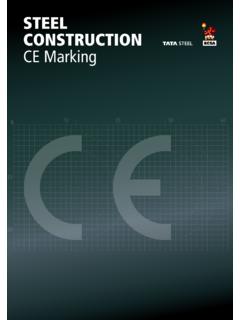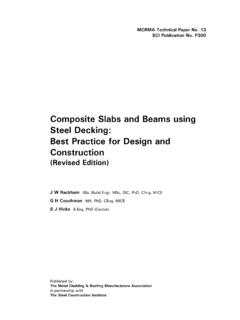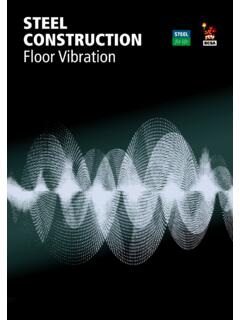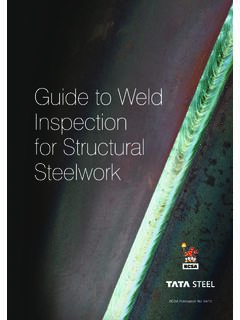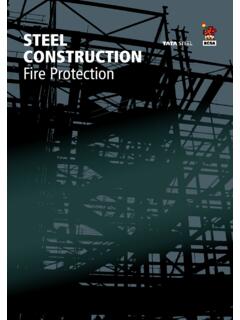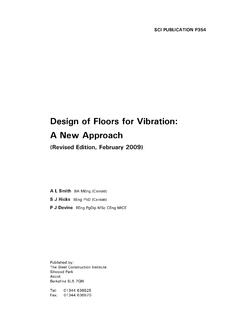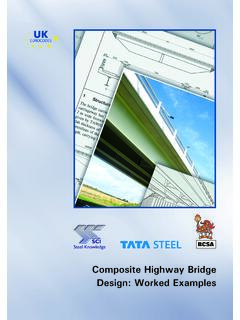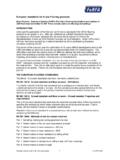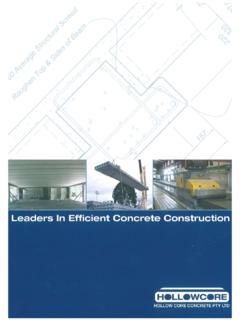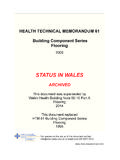Transcription of AD 410: Pouring concrete to a constant thickness or …
1 30 NSCS eptember 17 Advisory DeskComposite flooring systems comprising concrete and profiled steel decking supported by a grillage of primary and secondary steel members are a popular form of floor construction. The in-situ concrete acts compositely with the steel decking which acts as permanent formwork for the concrete and as external reinforcement to the composite slab. This AD Note is an update to guidance given in AD 344 Levelling techniques for composite floors and reflects the most recent practice in Pouring concrete to a constant level or thickness . However, the guidance in AD 344 is still valid. For composite flooring systems the concrete can be poured to a constant thickness or to a constant plane. The type of floor construction is one of the issues that must be determined at the design stage and it is important that this is communicated to the concrete contractor.
2 This AD Note describes the two methods that may be used to pour the concrete ( constant plane or constant thickness ), the expected surface finish (flatness and levelness) that may be achieved, the construction loads that should be taken in to account during design and the means of communicating the method of concreting to the concreting contractor. Design considerationsAn important design issue is to decide if the concrete is poured to a constant thickness or to a constant plane as the method of construction will affect the deflections of the steel decking and the steel frame and the amount of concrete placed. The two methods for concreting are: Pouring to a constant thickness and, Pouring to a constant constant thicknessConcreting a floor to a constant thickness can be achieved by using permanent proprietary formed tied construction joints, levelling pins (which are supported by either the steel decking and beams or the steel decking alone) or a depth gauge.
3 The term Structural floor level refers to the case where the screed rails etc. are supported by the steel decking and beams and the term constant depth refers to the case where the depth gauge or dip method is used. Both of these approaches are described Structural floor level. In this approach the reference points defining structural floor level are supported by the steel decking and beams at the design slab depth from the decking profile. The reference points are usually placed as close as possible to the beam centre-lines to avoid excessive displacement during concreting. However, they will drop as the decking and beams deflect as concreting proceeds. The slab thickness will remain as defined by the reference point and deck levels but the finished profile will not be the same as the original position of the reference points. This method should give reasonable control over both the concrete thickness and flatness (but not levelness).
4 This method will result in additional concrete (ponding) at mid-span decking regions as a result of deck deflection between the reference points. b. A constant depth using a depth gauge. In this approach the reference point is a rod with the constant depth set off the steel decking so that the top profile will be parallel to the decking profile. Good control of thickness should be achieved but the finished surface profile will depend on the initial profile and subsequent deflection of the steel deck and supporting beams. This is typically the recommended method and should always be used where the beams are pre-cambered. constant planeIn this method the finished concrete level is determined using a staff and level, often a laser level. As levelling is to a constant reference plane, any deflection of the steel decking and supporting beams as the concreting proceeds can give rise to a considerable increase in the slab thickness and the volume of concrete placed.
5 Additionally, previously levelled areas may drop as the supporting beams continue to deflect as adjacent areas are concreted. The fresh areas of concrete will continue to be levelled to the reference plane therefore small localised variations in level and flatness can occur across the slab pour. It is difficult with this method to achieve good control of level to datum, flatness and thickness . Using this method the slab thickness can be considerably thicker than designed due to the compound deflection of primary beam, secondary beams and steel decking. This depends on the centres and stiffness of the supporting beams. Tighter tolerances on levelIf tighter tolerances on floor level are required consideration should be given to providing a stiffer grillage of supporting primary and secondary floor beams. This will result in a combination of larger steel sections, short deck spans, more frequent beams and/or columns and possible a heavier gauge steel decking profile.
6 Where strict control of floor level is required it is suggested that the deflection of the steel under construction loads is limited to 10mm. This approach is often considered uneconomic. Alternatively propped construction may be used to reduce deflections during construction. However, use of propping should be considered at the design stage and not used as an afterthought on site. When a composite slab is propped during construction there is a higher demand on the shear connection between the decking and the concrete than in an unpropped slab, as a propped slab has to support the self-weight of the concrete through composite action. Consequently, a propped slab will have a higher degree of creep deflection under imposed loads than an unpropped slab, as well as the additional deflection of the decking under the self-weight of the concrete . A higher percentage of reinforcement must be specified for propped slabs to limit cracking over the supporting beams, and this clearly needs to be specified at the design stage.
7 Consideration should be given to deflections after the props are removed. Construction loads Clause (1) of BS EN 1994-1-1 gives recommendations for the actions to be considered during construction when the profiled sheeting is acting as permanent formwork. The following loads should be taken into account: Weight of concrete and steel deck, Construction loads including local heaping of concrete during construction, in accordance with clause of BS EN 1991-1-6, Storage load, if any, ponding effect (increased depth of concrete due to deflection of the sheeting)Clause of Technical Report 75 Composite concrete Slabs on Steel Decking by the concrete Society4 gives further information on the loads to be considered during concreting. With regard to ponding clause (2) of BS EN 1994-1-1 gives the following recommends: If the central deflection , , of the sheeting under its own weight plus that of the wet concrete , calculated for serviceability, is less than 1/10 of the slab depth, the ponding effect may be ignored in the design of the steel sheeting.
8 If this limit is exceeded, this effect should be allowed for. It may be assumed in design that the nominal thickness of the concrete is increased over the whole span by . Pre-cambering of beams is sometimes used to decrease the deflections from construction loads. Where pre-cambering is used, Clause of Technical Report 754 recommends that the composite floor slab is poured to a constant thickness . Unless the constant thickness method is used there is a risk that there will be insufficient cover to the mid-span of the beams should the camber not fully drop out . Traditionally, engineers have specified a pre-camber of only / to of the calculated simply supported deflection of the beam, or up to half the concrete cover to the decking (whichever is less). Doing this will greatly reduce the risk of a thin slab when the other methods of concreting are used. Flatness and level tolerancesThe main consideration with regards to the specification of tolerances is the building s use; buildings where the finished slab is to provide AD 410 : Pouring concrete to a constant thickness or to a constant plane31 NSCS eptember 17BS EN PUBLICATIONSBS EN ISO 636:2017 Welding consumables.
9 Rods, wires and deposits for tungsten inert gas welding of non-alloy and fine-grain steels. Classification Supersedes BS EN ISO 636:2015BS EN ISO 14343:2017 Welding consumables. Wire electrodes, strip electrodes, wires and rods for arc welding of stainless and heat resisting steels. Classification Supersedes BS EN ISO 14343:2009BS EN ISO 14713-1:2017 Zinc coatings. Guidelines and recommendations for the protection against corrosion of iron and steel in structures. General principles of design and corrosion resistance. Supersedes BS EN ISO 14713-1:2009BS EN ISO 14713-3:2017 Zinc coatings. Guidelines and recommendations for the protection against corrosion of iron and steel in structures. Sherardizing Supersedes BS EN ISO 14713-3:2009BE EN ISO 18276:2017 Welding consumables. Tubular cored electrodes for gas-shielded and non-gas-shielded metal arc welding of high strength steels. Classification Supersedes BS EN ISO 18276:2006 UPDATED BRITISH STANDARDSBS 8414-2:2015+A1:2017 Fire performance of external cladding systems.
10 Test method for non-loadbearing external cladding systems fixed to and supported by a structural steel frame AMENDMENT 1 BRITISH STANDARDS WITHDRAWNBS EN ISO 636:2015 Welding consumables. Rods, wires and deposits for tungsten inert gas welding of non-alloy and fine-grain steels. Classification Superseded by BS EN ISO 636:2017BS EN ISO 14343:2009 Welding consumables. Wire electrodes, strip electrodes, wires and rods for arc welding of stainless and heat resisting steels. Classification Superseded by BS EN ISO 14343:2017BS EN ISO 14713-1:2009 Zinc coatings. Guidelines and recommendations for the protection against corrosion of iron and steel in structures. General principles of design and corrosion resistance Superseded by BS EN ISO 14713:2017BS EN ISO 14713-3:2009 Zinc coatings. Guidelines and recommendations for the protection against corrosion of iron and steel in structures. Sherardizing Superseded by BS EN ISO 14713-3:2017BS EN ISO 18276:2006 Welding consumables.
